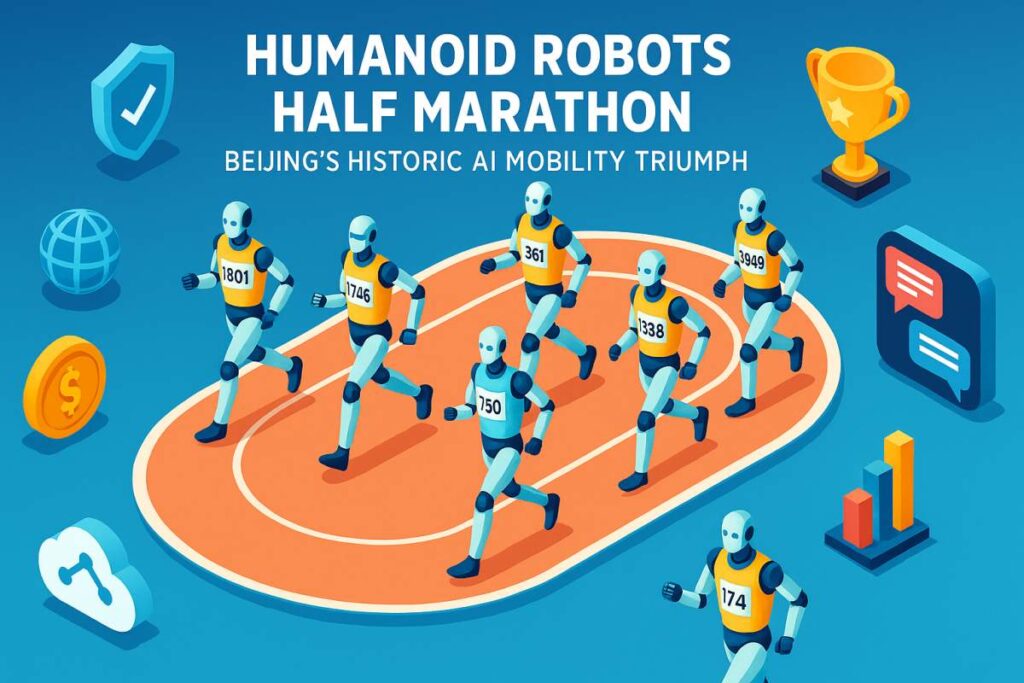A Race Unlike Any Other
Under the crisp morning sky of Beijing’s Olympic Park, an unusual group of competitors lined up for a half-marathon. Among the seasoned athletes stood 20 humanoid robots, their sensors gleaming and joints humming. By midday, these machines had etched their names into history, completing the 21.1-kilometer course and redefining what’s possible for AI-powered mobility. This wasn’t just a race—it was a watershed moment for robotics, blending endurance, adaptability, and cutting-edge technology.
Organized by the Beijing Robotics Institute in collaboration with tech giants like Xiaomi, UBTech, and Unitree, the event tested robots’ abilities to navigate urban terrain, sustain energy, and adapt to real-world unpredictability. For engineers and spectators alike, the success of these humanoid robots signals a future where machines could work alongside humans in disaster response, healthcare, and beyond.
But why a half-marathon? “Endurance races force robots to balance power, intelligence, and resilience,” explains Dr. Zhang Ming, lead organizer of the event. “It’s not just about speed—it’s about proving they can operate reliably in dynamic environments.”

Why This Humanoid robots half marathon Matters: A Milestone in Context
To grasp the significance of this achievement, consider how far robotics has come. In 2015, the DARPA Robotics Challenge required robots to perform tasks like opening doors and climbing stairs—at a painstakingly slow pace. Boston Dynamics’ Atlas robot later captivated audiences with parkour stunts, but these were short bursts of agility, not endurance.
Key Comparisons: From Lab Feats to Real-World Stamina
| Milestone | Year | Focus | Duration | Complexity |
|---|---|---|---|---|
| DARPA Robotics Challenge | 2015 | Task Completion | Minutes | Low Mobility |
| Atlas Robot Parkour | 2020 | Agility | Seconds | High Intensity |
| Beijing Half-Marathon | 2024 | Endurance & Adapt. | 3.5 Hours | Real-World Navigation |
This race pushed boundaries beyond isolated tasks or brief demonstrations. “It’s about sustained autonomy,” says Dr. Li Wei, a robotics engineer at Tsinghua University. “These robots had to manage battery life, uneven pavements, and even unexpected obstacles—like a spilled water station.”
The Tech Behind the Triumph
1. Energy Efficiency: Powering 21 Kilometers
Humanoid robots typically drain batteries within hours, but participants like Xiaomi’s CyberOne utilized swappable battery packs and kinetic energy recovery systems (KERS). By converting motion into stored power—similar to regenerative braking in electric cars—they extended operational time by 40%.
Case Study:
Unitree’s H1 robot, which finished third, employed a hybrid power system combining lithium-ion batteries with supercapacitors. The latter handled peak energy demands (e.g., climbing stairs), while the former provided steady output. “It’s like a sprinter and a marathon runner in one body,” says Unitree engineer Zhao Lin.
2. Adaptive AI: Learning on the Move
Unlike pre-programmed routes, robots relied on real-time data from LiDAR, cameras, and proprioceptive sensors. UBTech’s Walker X, for instance, adjusted its gait dynamically when encountering potholes, a feature honed through reinforcement learning.
How It Works:
- LiDAR: Mapped terrain up to 50 meters ahead.
- Cameras: Identified obstacles (e.g., spectators, signage) using NVIDIA’s edge-computing chips.
- Proprioceptive Sensors: Monitored joint angles and force to prevent falls.
“These robots don’t just ‘see’—they feel their environment,” says Dr. Emma Rogers, a Stanford robotics researcher.
3. Durability in the Wild
Beijing’s urban course included stairs, curbs, and crowds. Engineers prioritized lightweight materials (e.g., carbon fiber limbs) and waterproofing to handle a sudden drizzle mid-race.
Material Innovations:
- Carbon Fiber Frames: Reduced weight by 30% compared to aluminum.
- Self-Healing Polymer Joints: Repaired minor cracks during rest intervals.
Hurdles on the Track: Challenges Overcome
Despite the triumph, the race exposed lingering hurdles:
1. Balance Under Fatigue
As batteries depleted, some robots staggered. Unitree’s H1 optimized weight distribution mid-stride to prevent falls. “Balance algorithms had to recalibrate every 10 seconds,” explains Zhao Lin.
2. Human-Robot Interaction
Crowd noise disrupted audio sensors, forcing bots to rely more on visual cues. “One robot misinterpreted a cheer as a collision warning,” laughs spectator Maria Chen.
3. Ethical Safeguards
Organizers implemented emergency stop protocols to avoid collisions, sparking debates about autonomy vs. safety. “If a robot stops too often, it fails the race. If it doesn’t stop, it risks harm. It’s a delicate balance,” says ethicist Dr. Hiroshi Tanaka.
The Global Race: How Beijing Stacks Up
While China’s half-marathon made headlines, it’s part of a broader global push for humanoid robotics:
1. Japan’s RoboMarathon
Since 2015, Osaka’s RoboMarathon has hosted bipedal robots racing 42.2 kilometers—but over days, not hours. “Beijing’s focus on speed and real-time adaptation is revolutionary,” says RoboMarathon organizer Kenji Sato.
2. U.S. Military Trials
The Pentagon’s Advanced Robotics for Manufacturing (ARM) Institute recently tested humanoid robots for warehouse logistics. However, their tasks lacked the unpredictability of Beijing’s urban course.
3. European Union’s Ethical Framework
The EU’s 2023 AI Act mandates strict safety assessments for humanoid robots, potentially slowing commercial adoption. “China’s event shows what’s technically possible, but ethics can’t be an afterthought,” argues EU tech policy lead Margrethe Vestager.
Beyond the Finish Line: Implications for the Future
The Beijing marathon isn’t just a novelty—it’s a blueprint for practical applications:
1. Disaster Zones
Robots could traverse rubble for search-and-rescue missions. “Imagine a robot climbing through earthquake debris for 12 hours straight,” says Dr. Zhang Ming.
2. Elder Care
With China’s aging population, assistive robots might support daily mobility. Trials in Shanghai nursing homes show robots helping residents walk or fetch items.
3. Logistics
Companies like Amazon and Alibaba are testing humanoid robots for warehouse navigation. “Their ability to handle stairs and ramps could revolutionize delivery,” says Alibaba AI lead Wang Jun.
The Roadblocks Ahead: Cost, Trust, and Jobs
While the technology excites, challenges remain:
1. Prohibitive Costs
Current models exceed $100,000, limiting scalability. Xiaomi aims to slash prices by 60% by 2026 using modular designs.
2. Public Skepticism
A 2024 Pew Research study found 52% of respondents distrust robots in caregiving roles. “We need transparency in how AI decisions are made,” argues ethicist Dr. Tanaka.
3. Workforce Disruption
The International Federation of Robotics predicts 20 million jobs could be automated by 2030. However, new roles in robot maintenance and programming may offset losses.
Final Lap: A Call to Embrace the Journey
As these robots crossed the finish line, they didn’t just make history—they invited us to reimagine our relationship with technology. The Beijing Humanoid robots half marathon proves that AI-powered mobility is no longer sci-fi; it’s a tangible, evolving reality.
What’s next? Perhaps a full marathon, or robots assisting in climate research on Antarctica’s icy plains. The race has just begun.
Your Move: How do you envision humanoid robots shaping our future? Share your thoughts below or explore our deep dive into AI in healthcare to see where else this tech could sprint ahead.
What do you think—is the age of humanoid helpers upon us, or is there still a marathon’s worth of innovation left? Share your thoughts below, subscribe to our newsletter for deep dives on robotics, and explore related stories on TransformInfoAI.com!


